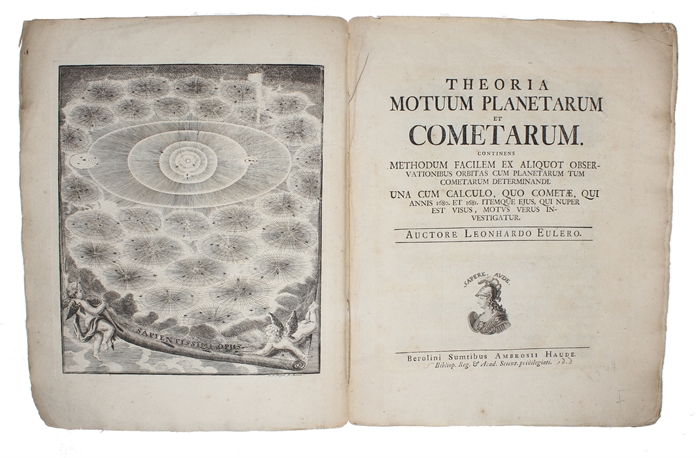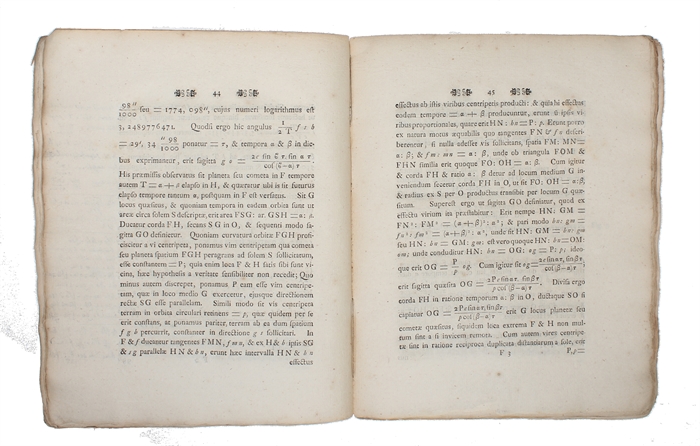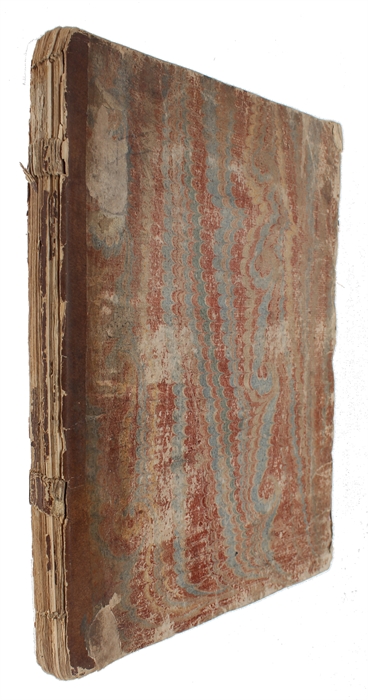EULER'S FIRST WORK IN ASTRONOMY
EULER, LEONARD.
Theoria motuum planetarum et cometarum. Continens methodum facilem ex aliquot observationibus orbitas cum planetarum tum cometarum determinandi. Una cum calculo, quo cometae, qui annis 1680 et 1681. Itemque ejus, qui nuper est visus, motus verus investigatur.
Berlin: Ambrosii Haude, 1744.
4to. (246x199mm). Uncut in original marbled paper wrappers. Spine strip nearly worn away, but sewing still strong. A fine copy in its original and untouched state. Large engraved frontispiece showing comets orbiting the sun and planets, 187 pp. and 4 copper engraved folding plates. A4 (pp.7-8) canceled - catchword continues. Complete.
First edition of this important work containing the first complete mathematical treatment of the two-body problem, consisting in a planet and the Sun. Great minds such as Newton, Bernoulli and Poincaré all made important contributions to solving the exceedingly important mathematical Two-Body Problem, but Euler here gave the first full exposition of it.
"In 1744, Euler developed the first completely analytical method for determining a parabolic orbit through successive approximations in his Theory of the Motion of Planets and Comets. This was built upon Newton's earlier work, which [...] tended to be very complex and messy and incomplete. Today, the method of successive approximation known to every student of calculus is known by this man's name, Euler's Method." (Summy, Analysis of the Two-Body and Restricted Three-Body Problem, p. 4).
In the present work Euler gives "the solutions of the main problems of theoretical astronomy dealing with the structure, nature, motion and action of comets and planets. With regard to the theory of perturbed motion of celestial bodies, Euler formulated the perturbation theory in general terms so that it can be used to solve the mathematical problem of dynamic models and particular problems of theoretical astronomy [...] He gave an extensive mathematical treatment of the problem of improving approximations of orbits within the framework of the two-body problem and taking perturbations into account. In his Theoria motuum planetarum et cometarum published in 1744, Euler gave a complete mathematical treatment of the two-body problem consisting of a planet and the Sun." (Debnath, The Legacy of Leonhard Euler, p. 364).
In 1687, in the 'Principia', Newton had solved the problem geometrically; In 1710 Johann Bernoulli had proved that the motion of one particle with respect to the other is described by a conic section; In 1734 Daniel Bernoulli won a French Academy prize for his analytical treatment of the Two Body problem - but it was Euler, with his present work, who gave the fully complete mathematical treatment of the problem.
Enestroem E66,
Houzeau & Lancaster 11948
The Barchas Collection 649
Honeyman 1063
Order-nr.: 38114



